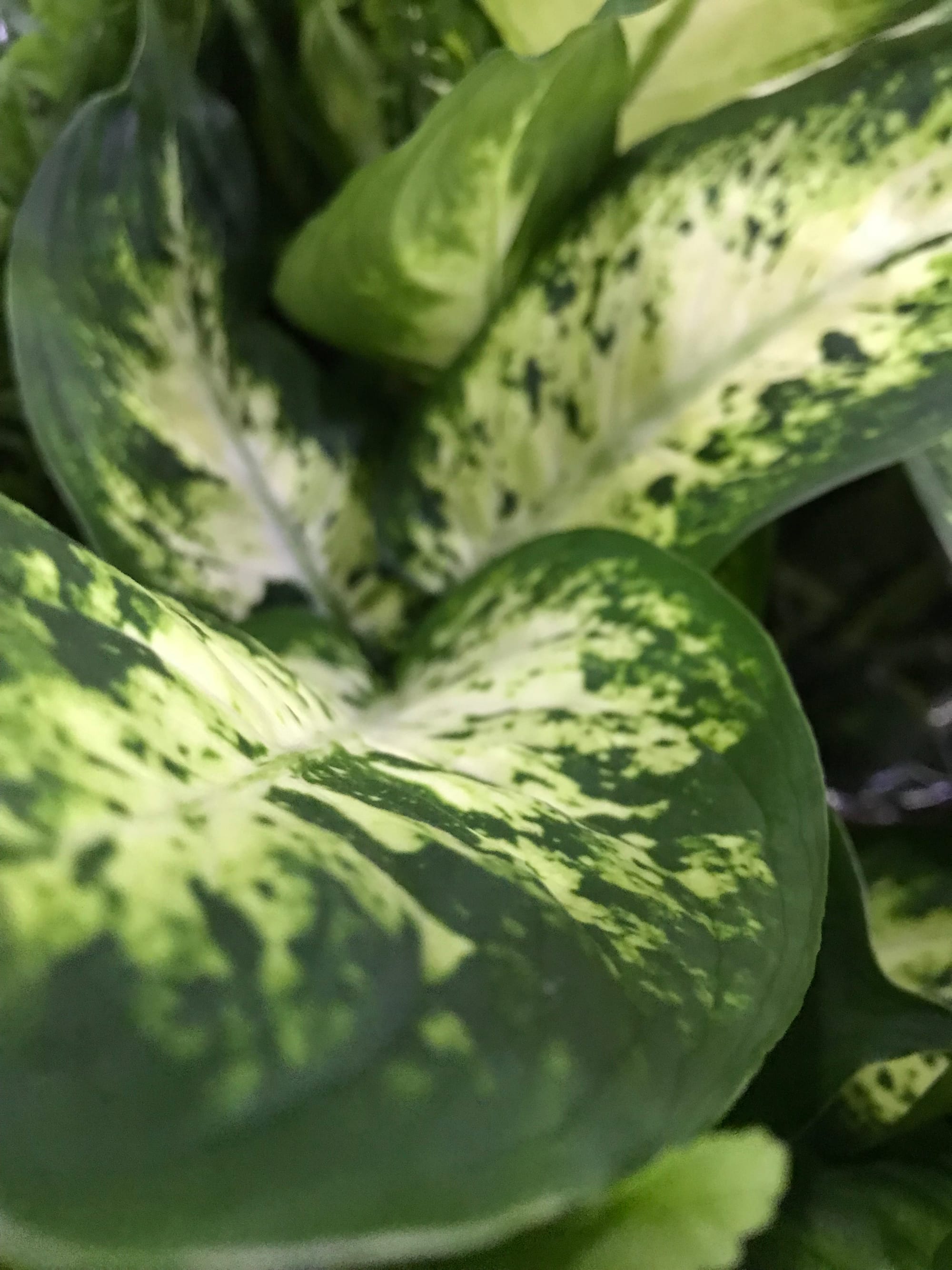
Dieffenbachia seguine 'Tropic Snow'
Listen to the Dumb Cane Podcast Here!
Contents
- Top Tips
- Location, Water, Humidity & Fertilisation
- Common Issues
- Origins, Temperature, Propagation, Repotting & Toxicity.
Need the answer to a specific plant query? Book a 1-to-1 video call with THE HOUSEPLANT DOCTOR™, the website's friendly author, to overcome and address your niggling problem! Available on iMessage, WhatsApp, Facebook Messenger & more.
Top Tips & Info
- Care Difficulty - Moderate
- Provide a bright, indirect setting away from the direct sunlight. Avoid placing it within a few metres of an operating heater or in excessively dark locations to decrease the chance of death.
- Keep the soil evenly moist, allowing the top third to dry out in between waters. Reduce this further during the colder months of the year to replicate their much-needed dormancy period.
- Root rot is the most common issue with Dumb Canes, so ensure you're keeping the soil on the drier side to life.
- Fertilise using a 'Houseplant' labelled feed every four waters in the spring and summer, reducing this to every six in the colder months.
- Repot every two years with a 'Houseplant' potting mix & the next sized pot.
- Keep an eye out for Spider Mites & Mealybugs throughout the year, & Thrips during the start of summer.
Location & Light - 🔸🔸
An environment that consists of reliable humidity and temperature should be at the forefront of a Dumb Cane. Once you're happy with its new location, provide a bright, indirect setting away from the direct sunlight. Although shady spots should be avoided if possible, you can help the situation by regularly rinsing its foliage with lukewarm water to remove the thin level of dust that covers the leaves. Never situate this plant within four metres of an operating radiator.
Water - 🔸🔸
Allow the soil's top third to dry out in between waters, reducing this further in the autumn and winter. The best indication as to when the plant will require another water is once the pot feels light when lifted. Due to the sensitivity of its root systems, never apply cold water as it may weaken its health and well-being over time. For those that use tap water (instead of rainwater or fresh bottled water), allow it to stand for at least 24hrs to settle the high levels of chloride and fluoride found from the tap. Under-watering symptoms include brown leaf edges and stunted or deformed growth; these issues are typically down to either too much light/heat or forgetfulness. Over-watering symptoms include yellowing leaves, little to no new growth and a rotting stem. In severe cases, the chances of saving the plant can be slim, so performing stem cuttings is the only option to keep the specimen alive - scroll down to 'Propagation' for more information.
Remember - The amount of light and current season of the year will directly govern the frequencies of waters per month. Specimens placed in darker areas must be kept on the drier side to life, whereas brighter locations will require more soil moisture to lubricate photosynthesis.
Humidity - 🔸🔸
Create a humidity tray to provide a moist and stable environment for your plant. If the surrounding saturation is too low or the heat too high, its leaf-tips may start to brown over and curl, especially in direct sunlight. Hose the foliage down from time to time to hydrate the leaves and keep the dust levels down.
Do not rely on misting to provide a moist environment; constant humidity fluctuations will result in poor growth and yellow lower leaves.
Fertilisation - 🔸🔸
Feed every four waters during the growing period and every six in the autumn and winter, using a 'Houseplant' labelled fertiliser. Never apply a 'Ready to Use’ product into the soil without a pre-water first, as it may burn the roots and lead to yellowed leaves.
Common Issues with Dieffenbachia (Dumb Canes)
Yellowing lower leaves (closest to soil) are a clear sign of over-watering or root rot, often caused by too little light or low temperatures. Although they can do well in darker locations, the frequency of irrigations must be reduced to counteract the chance of root rot. People don't realise that a plant's root system needs access to oxygen too; when soil is watered, the air will travel upwards and out of the potting mix. A lack of accessible oxygen for the roots will cause them to subsequently breakdown over the oncoming days. Click on this link to learn more about root rot and how to address it, and always feel the pot's weight for confirmation (heavy pot = adequate soil moisture). Scroll down to the last image to see an example of a healthy root system.
Sudden lower leaf-loss is a common and significant issue among gardeners. This unfortunate phenomenon could be a product of several different problems, most notably being dark locations, water-related abuse or environmental shock. Introduce the plant to a more well-lit area with a splash of off-peak sunlight; if caught in time, the leaf-loss should stop within a few weeks. If you feel that you're watering habits aren't up to scratch, familiarise yourself with our care tips provided at the top of this article. It's always best to under-water an indoor Dumb Cane than over-do it, purely on its poor ability to endure continued sogginess. The final culprit could be down to a sudden relocation; if you've recently purchased the specimen within the last six weeks, the chances are it is still acclimatising to the new environment. Although this shouldn't happen, a vastly different setting will cause sudden foliage-loss and stunted growth. You'll have two options of either waiting it out or presenting a more Dieffenbachia-friendly environment, mentioned in the 'Location & Light' section. We would fertilise the plant the next time it needs a water, using a 'Houseplant' labelled feed. If you're still unsure of what to do, never hesitate to book a 1-to-1 call with THE HOUSEPLANT DOCTOR™ to get his expert advice on this issue!
Too low humidity can cause browning leaf tips with yellow halos. Although this won't kill your specimen, you may want to increase the local moisture to prevent the new growth from adopting these symptoms. Mist or rinse the foliage from time to time and create a humidity tray whilst the heaters are active to create a stable environment for your specimen.
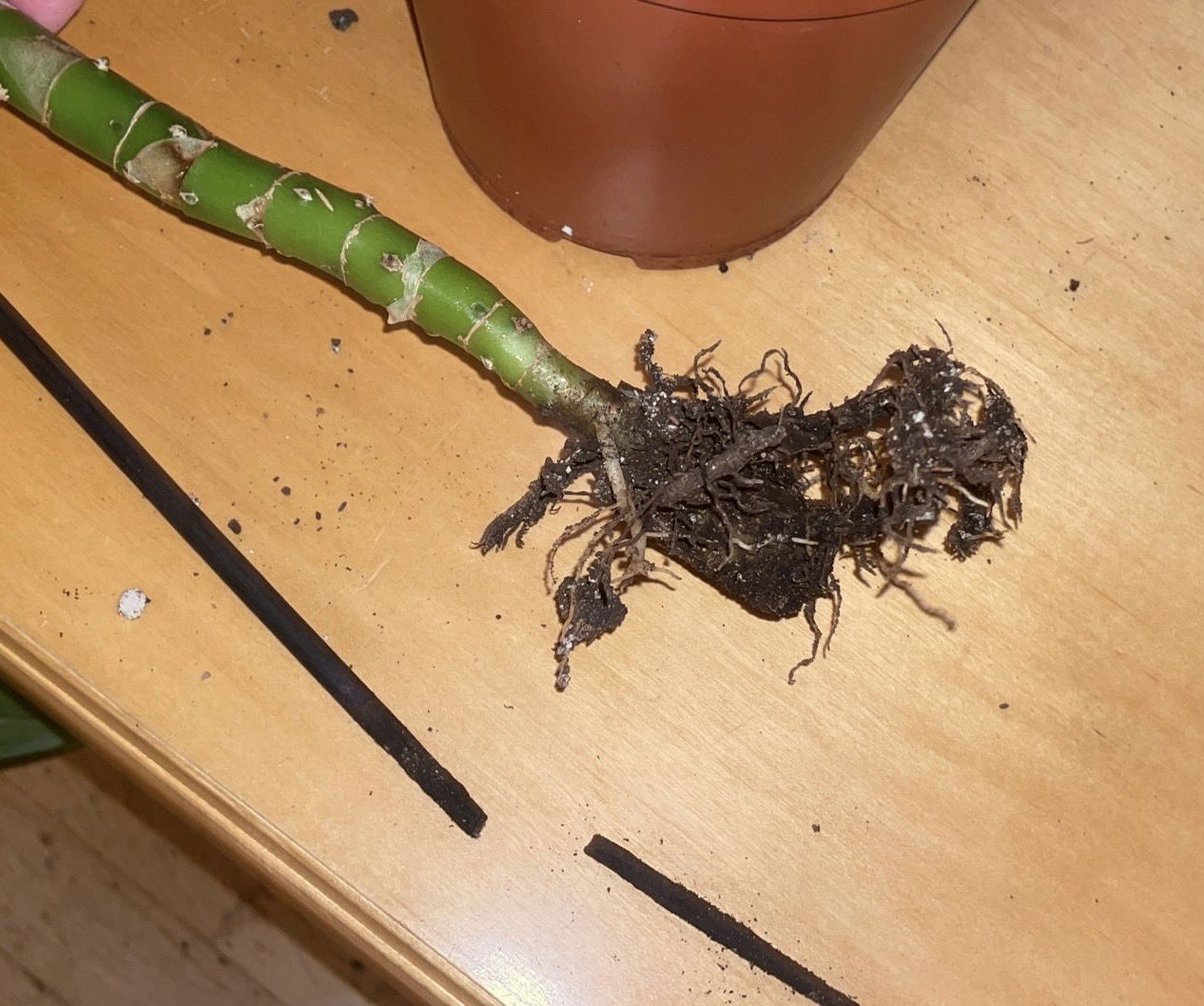 Root rot is a common problem with Dumb Canes due to its intolerance to long periods of moist/wet soil. If most of the roots have rotten & browned over, consider repotting into a smaller plastic pot & prune the leaves in half (width-ways) to reduce the length of the leaf & transpiration loss.
Root rot is a common problem with Dumb Canes due to its intolerance to long periods of moist/wet soil. If most of the roots have rotten & browned over, consider repotting into a smaller plastic pot & prune the leaves in half (width-ways) to reduce the length of the leaf & transpiration loss.
A loss of variegations is caused by too little light. Although Dumb Canes are an excellent choice for shady locations, it'll come at the cost of their variegations. Move the plant into a brighter area with minimal direct sunlight to allow the variegations to appear on the new growth. If you aren't entirely displeased about the loss, simply skip this step. Alternatively, extreme variegations that hinder the plant from developing chlorophyll (green pigmentation) is typically caused by too much sunlight.
Pests could arise at any time, with infestations starting from the original nursery or via contamination in your home. With Dumb Canes, Spider Mites and Mealybugs tend to be the usual inhabitants, with the first being minute and almost transparent, roaming the leaves in search of chlorophyll and a site to hide its eggs. The latter, however, will stand out much more, with white cottony webs developing across the foliage and stems. Thoroughly check the plant's cubbyholes before giving it the all-clear, or click on the appropriate links to learn more about eradicating these issues.
Always use lukewarm water, and if you choose to use tap water, allow it to stand for at least 24hrs before application. Dumb Canes tend to be quite sensitive to temperature change, so pouring cold tap water immediately into the pot will not only add fluoride into the soil, but it could even lead to yellowed leaves over time.
Curled/softened leaves & brown leaf-edges are the result of too little water and over-exposure to the sun. (Image below). Dumb Canes are best located in bright, indirect settings, and those that haven't acclimatised to the harsh rays will show signs of sun-scorch and environmental shock. A splash of winter sunlight is acceptable as long as the soil moisture is regularly observed, with complete avoidance once summer comes along.
Finally, failed propagated stem cuttings - There are several reasons why the cuttings haven't rooted well, including: the time of year (spring or summer is best), its size (Dumb Cane cuttings should have at least five leaves, or 10cm stem length), poor growing conditions (replace water weekly for water-propagated cuttings, and avoid over-watering for soil-grown plants), and its growing environment (a bright sunless windowsill and warmth is important).
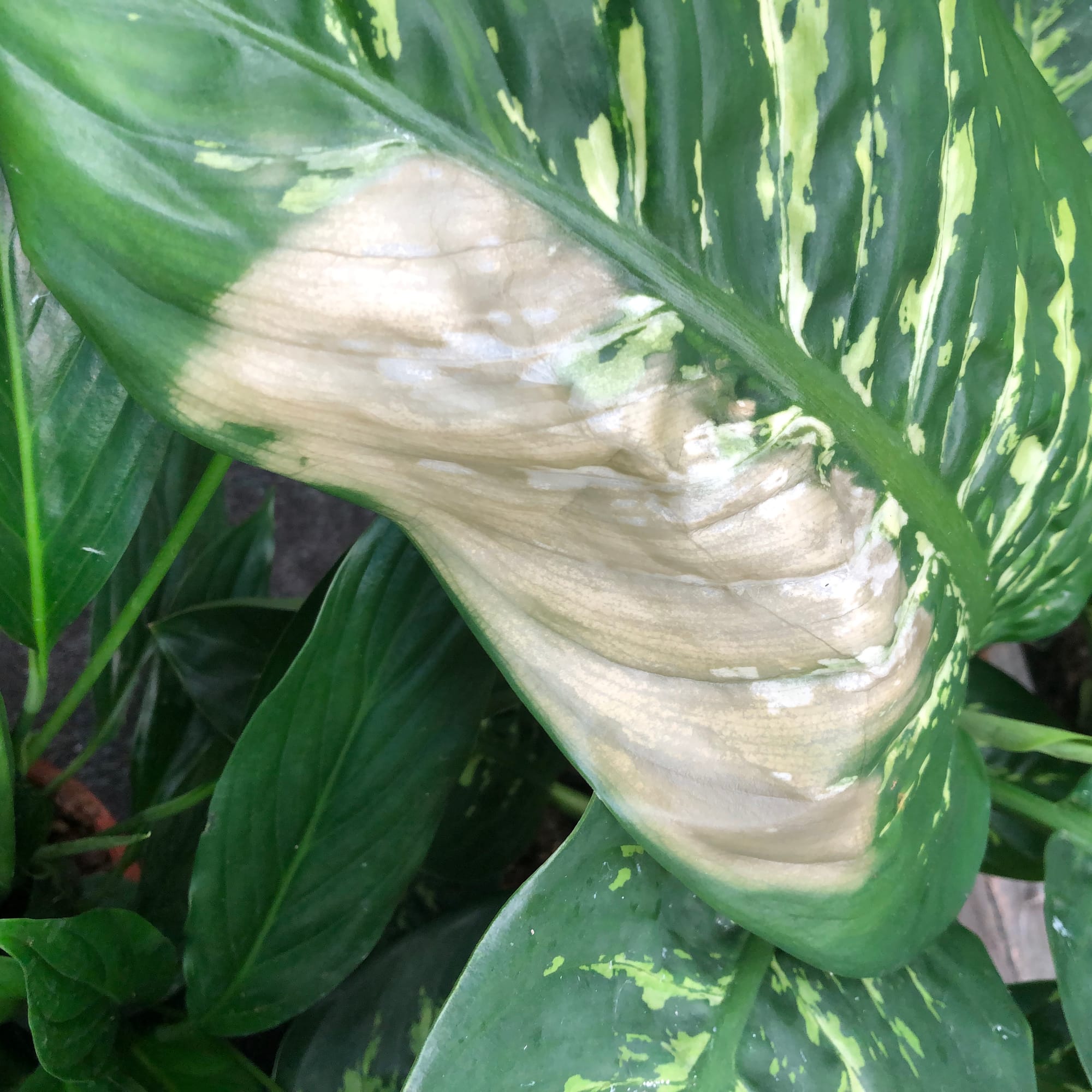 The result of sun-scorch & temperatures that have caused the leaf to burn.
The result of sun-scorch & temperatures that have caused the leaf to burn.
Origins
Dieffenbachia consists of around sixty species, all of which are native to Tropical America. The genus was penned by Heinrich Schott in 1829, honouring his head-gardener, Joseph Dieffenbach. Its nickname, the dumb cane, refers to the poisoning of calcium oxalate crystals found in the stems, that can cause temporary speechlessness and irritation of the pharynx.
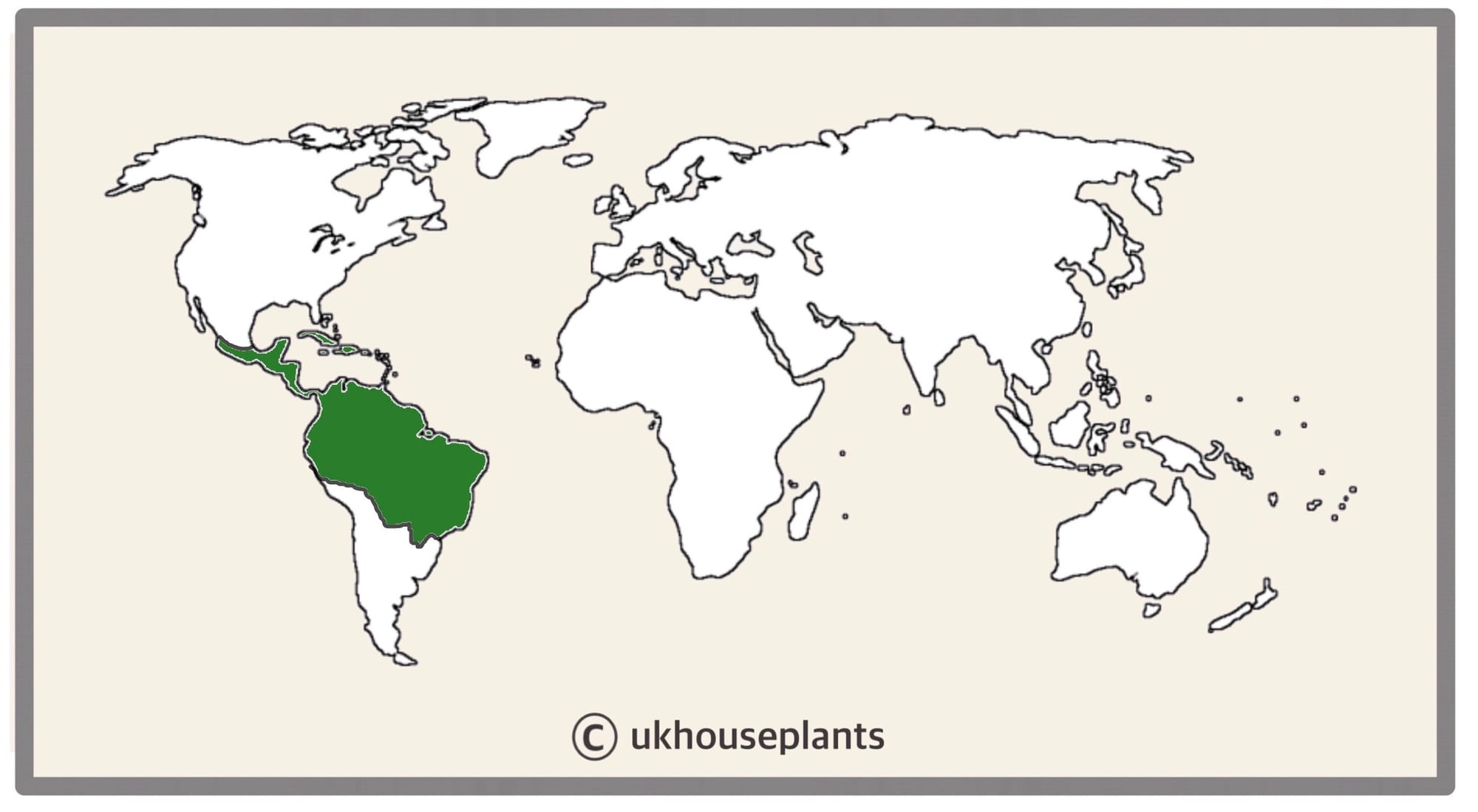 The Distribution of Dieffenbachia
The Distribution of Dieffenbachia
Temperature
15° - 24°C (59° - 75°F)
H1a (Hardiness Zone 13) - Must be grown indoors or under glass all year round. Never allow temperatures to dip below 15℃ or permanent damage may occur in the likes of flower loss, stunted growth and yellowed leaves.
Spread
Up to 3m in height and 0.8m in width once they reach maturity of around 5 - 8 years.
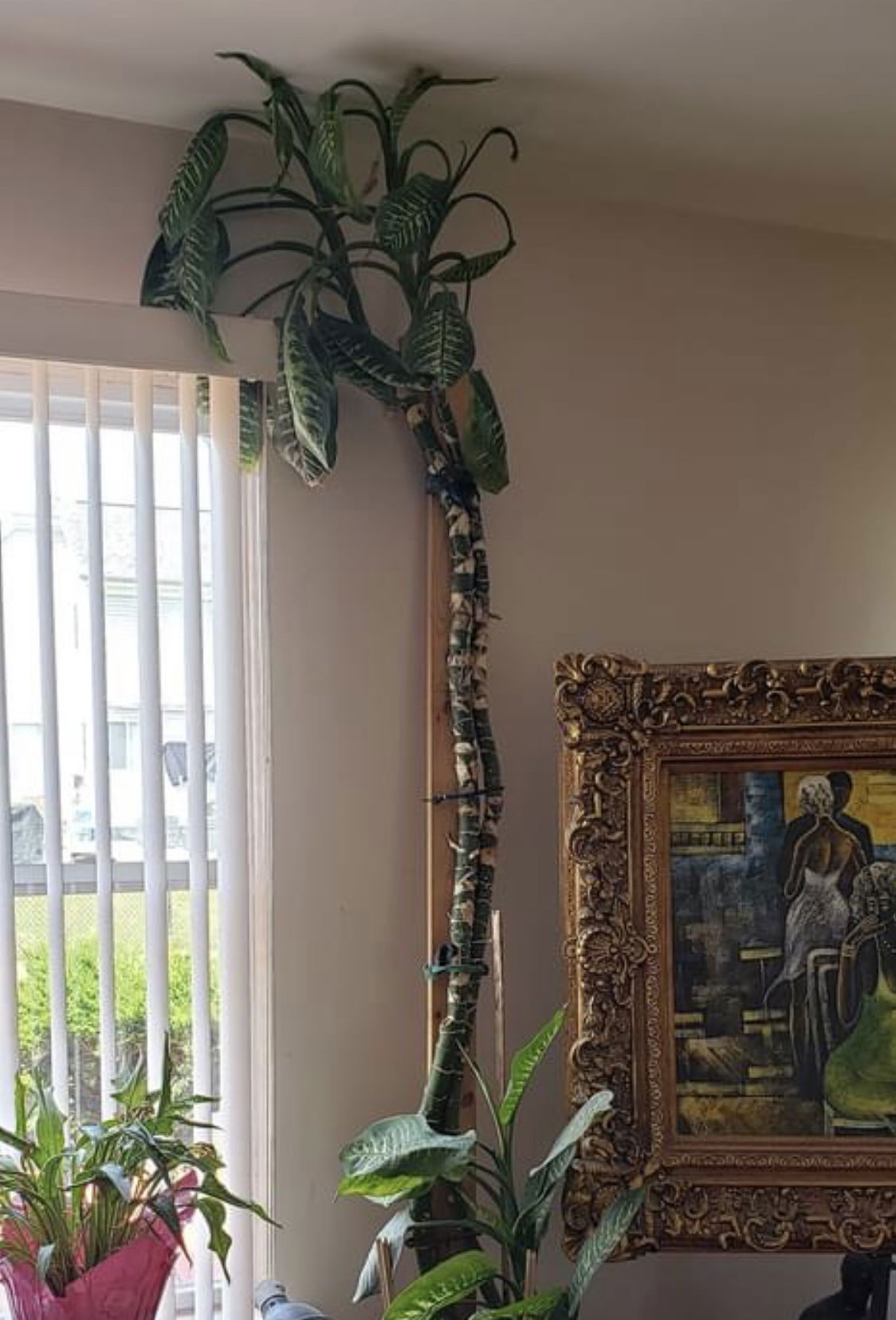 Here's one of our readers' Dumb Cane that's a whopping 3m in height! At this point, you can take 30cm (1ft) stem cuttings to reduce its overall height and double your stock through propagation. Credit: Mary
Here's one of our readers' Dumb Cane that's a whopping 3m in height! At this point, you can take 30cm (1ft) stem cuttings to reduce its overall height and double your stock through propagation. Credit: Mary
Pruning & Maintenance
Remove yellow or dying leaves, and plant debris to encourage better-growing conditions. While pruning, always use clean scissors or shears to reduce the chance of bacterial and fungal diseases. Never cut through yellowed tissue as this may cause further damage in the likes of diseases or bacterial infections. Remember to make clean incisions as too-damaged wounds may shock the plant, causing weakened growth and a decline in health.
Propagation
Via Seed, Offset Division, Stub Cuttings & Stem Cuttings.
Basal Offset Division (Easy) - Your plant will produce several basal offsets that can be separated once they have a sufficient root system, and surpass 10cm in height. If possible, water the soil 24hrs before the main event to reduce the risk of transplant shock, when its dry root systems are over-fingered. Take the plant out of its pot and place your fingers close to the nodal junction - soil may have to be removed for better access. Push the chosen offset downwards until you hear a snap. Separate the foliage and its root system away from the mother plant, mentally noting the high risk of damage. Transplant in the appropriate sized pot with a fresh batch of 'Houseplant' soil. Maintain evenly moist soil and situate it in a bright, indirect location away from any direct sunlight. After eight weeks, treat it like a normal specimen, following the care tips above!
For stub cuttings (Difficult), cut the thinner stem into 10cm (4 inches) intervals, and place in moist soil, with the bottom end around 2cm (0.8 inches) deep - think of a pencil's width and diameter. If possible, use a well-draining potting mix like 'Houseplant' Compost and place the stub cuttings into a small-holed transparent bag with continual soil moisture. Once a flurry of new leaves appears, remove the bag and treat like a typical plant. Avoid direct sunlight and temperatures below for best results.
Stem Cuttings (Moderate) can be taken at the start of spring when there's more than 12cm (4.7 inches) of semi-wooded stem. This will take a while, as the plant will need to reach a certain level of maturity before its base becomes ready. While using clean secateurs, remove the top 12cm of the stem just above a node and gently remove the lower leaves. Set the bottom half into water for root development. After 5cm (2 inches) of root growth, which can take several months, set the rooted portion into moist 'Houseplant' compost. Wrap the plant (& its pot) in a transparent bag to maintain high humidity due to the absence of roots that'll result in rapid moisture loss within the stem. Provide a bright, indirect location with continual soil moisture to quicken the rate of root development. Remove the bag after it grows its second leaf and follow the care advice provided at the top of the article.
Flowers
As Dieffenbachia is part of the Araceæ family, their flowers aren't showy. Much like a Peace Lily's flower body, their flowers consist of a white or green spathe (the spoon-like shell) with the spadix being the site pollination. Blooms can last up to five days and is usually visible during late spring or early summer around 30cm+ from the soil line; however, achieving a flower is highly unlikely indoors.
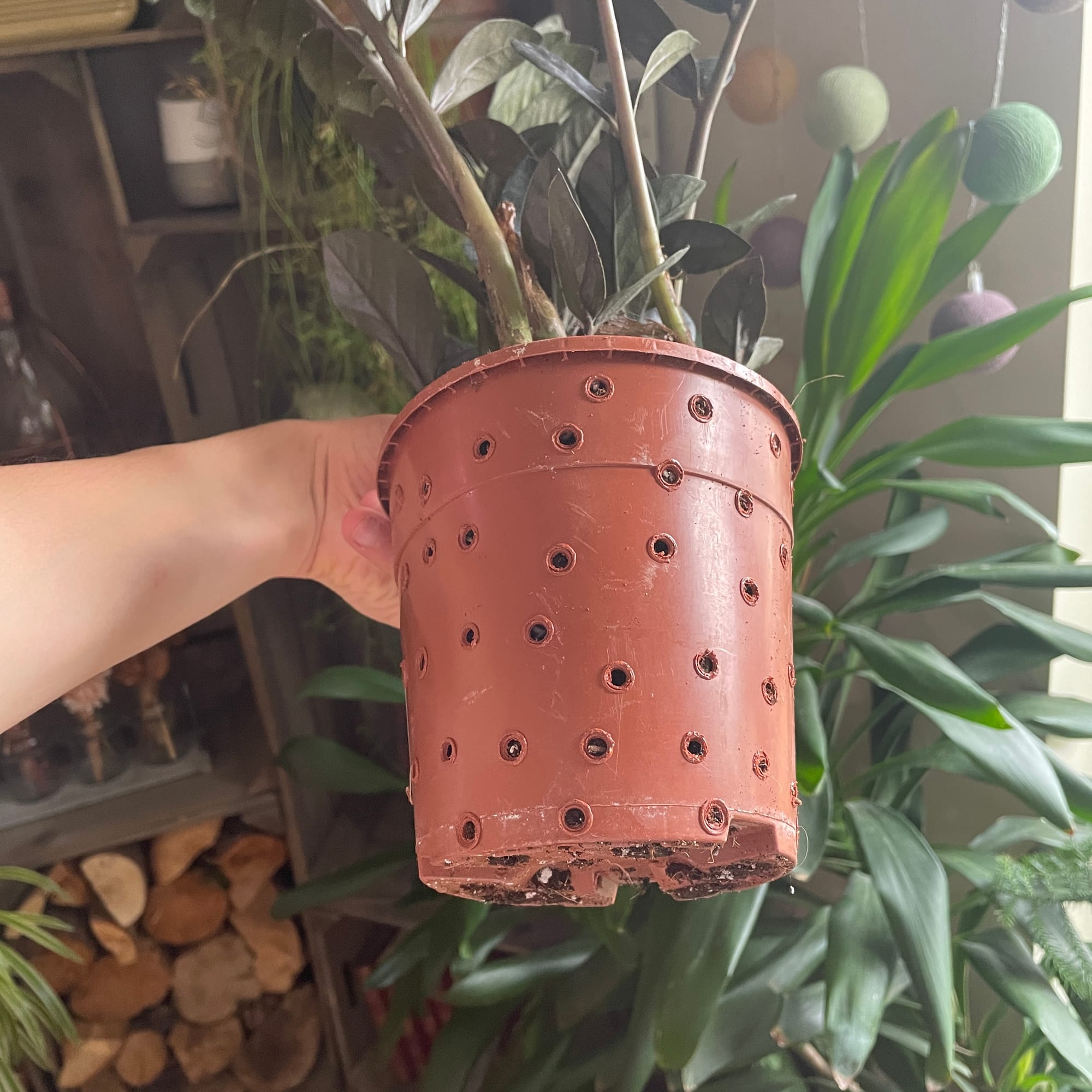 Similarly to the ZZ Plant (pictured), your Dumb Cane will benefit from having a few holes in its plastic pot to reduce the risk of root rot. We recommend using a Soldering Iron.
Similarly to the ZZ Plant (pictured), your Dumb Cane will benefit from having a few holes in its plastic pot to reduce the risk of root rot. We recommend using a Soldering Iron.
Repotting
Repot every two years in the spring, using a 'Houseplant' labelled compost and the next sized pot with adequate drainage. Hydrate the plant 24hrs before tinkering with the roots to prevent the risk of transplant shock. For those that are situated in a darker location, add a thin layer of small grit in the pot's base to improve drainage and downplay over-watering. Click here for a detailed step-by-step guide on transplantation, or via this link to learn about repotting with root rot.
Book a 1-to-1 video call with THE HOUSEPLANT DOCTOR™ if you'd like a personal guide to repotting your houseplant. This will include recommending the right branded-compost and pot size, followed by a live video call whilst you transplant the specimen for step-by-step guidance and answer any further questions!
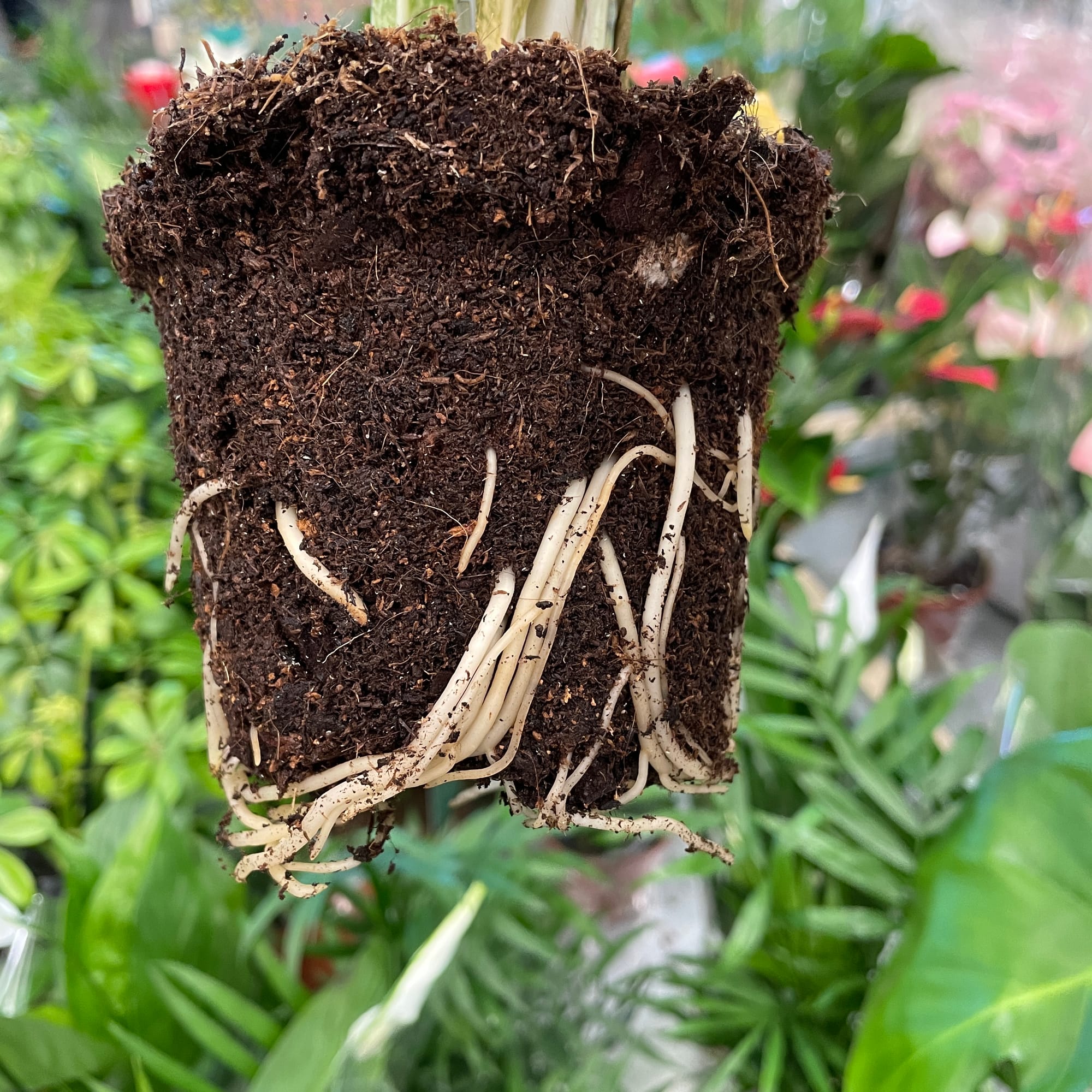 Here's an example of a healthy Dieffenbachia root system.
Here's an example of a healthy Dieffenbachia root system.
Pests & Diseases
Keep an eye out for mealybugs, spider mites, scale & thrips. Typical diseases associated with this genus are leaf-spot disease, rust, botrytis & root rot. Click on this link for further information about how to identify and address any of these issues.
Toxicity
This plant is classified as poisonous due to varying concentrations of calcium oxalate crystals found around the plant's body. If parts of the plants are eaten, vomiting, nausea and a loss of appetite could occur. Consumption of large quantities must be dealt with quickly; acquire medical assistance for further information.
Retail Locations
B&Q, Blue Diamond, Online Stores.
Book a 1-to-1 Call with THE HOUSEPLANT DOCTOR™
If you need further advice with your houseplants, book an advice call with ukhouseplants' friendly and expert writer today! This can be done via a video or audio call on most apps, including Facebook, FaceTime & Skype. A ten-minute call costs £5.99 (US$7), or £15.99 for thirty minutes. You can ask multiple questions, including queries on plants, pests, terrariums, repotting advice and anything in between. Please consider supporting this service to keep ukhouseplants thriving!